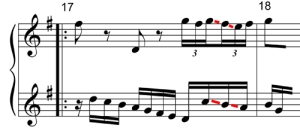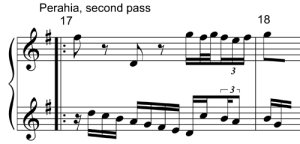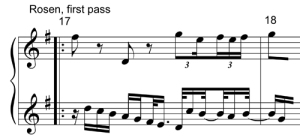I absolutely love the Goldberg Variations. I even took the time (a lot of time!) to arrange a version of them myself. But something has always bothered me about measure 17 in the fifth variation of Bach’s Goldberg Variations. Below are measures 17-18, the first being from the first edition of the score, the second from the Bach-Gesellschaft Ausgabe:
It’s been said that every time someone writes or plays parallel fifths, Bach kills a kitten. Good luck playing the beat 3 ornament in measure 17 without killing at least one cat. You may even kill a couple. If you want to find them yourself before reading on, think about how that ornament might be rendered. (Keep in mind that this variation is invariably played at a faster tempo.)
The ornament figure contains three elements: a “prefix” (the scoop at its beginning), a trill and a mordant or “termination.” Below, in J. S. Bach’s handwriting, is a preface to Klavierbüchlein für Wilhelm Friedemann Bach. A clearer version of this chart in modern notation is found here. 
According to this chart, the 17th measure of the 5th Goldberg Variation should be rendered as follows:
Rendered in such a way, no objectionably part-writing parallels occur. In reality, however, such a realization of this figure would be far too rapid to be executed given the quick tempo at which this variation is invariably taken. More realistically, the figure could be taken at half speed. But in doing so, parallels suddenly occur on the fourth 16th of beat three: F#—E over B—A.
However, this particular ornament is more commonly rendered in performance as a 6-note sextuplet figure that neglects the opening prefix: G—F#—G—F#—E—F#. If played precisely, not one but two sets of parallels emerge, one on third 16th of beat three (G—F# over C—B) and the other near the fourth 16th of beat three, only slightly misaligned.
Again, this is the most common, that is, the usual rendering of this measure, producing three consecutive P5s in a row! And it really bothers me.
FURTHER RESEARCH
Then I got curious. Taking the nine recordings of the Goldberg sitting on my CD shelf altogether, just how many kittens are killed in total? Let’s get to the bottom of this important matter and analyze them one by one.
GOULD 1957 & 1981
Many people know of the two studio recordings Gould made of the Goldberg, recordings that bookend his all-too-short career. Less well known is the 1957 live Salzburg & Moscow recording. For our present research, I take this 1957 together with the 1981 recording because Gould takes the same interpretation in both—he simply plays the F# as a quarter note, without ornamentation.
That’s one way to avoid the parallels! With the potential for two parallels in each recording, four kittens’ lives are saved. (I say four instead of eight because Gould elects not to repeat the second half of this variation in both recordings. Most pianists, of course, repeat the second half.)
TOTAL KITTEN BODY COUNT: 0
GOULD 1955
In his 1955 debut recording of the Goldberg, Gould does elect to add the ornament. The audio below presents the passage at full speed, then at half speed, then at one-quarter speed. While the slowed version is rather grainy, Gould appears to render the figure straightforwardly as the “usual” sextuplet figure notated above.
The graininess of this early recording does make it difficult to assess, but even with the second F# in the figure not projecting well, I would venture to say that two kittens died in this rendering.
TOTAL KITTEN BODY COUNT: 2
SCHIFF 1982
Andras Schiff recorded the Goldberg multiple times. In this 1982 release, Schiff’s rendering is, as always, quite nuanced. In the audio excerpt below, you will hear Schiff’s first pass at the passage (at the three different speeds) followed by his second pass.
In the first pass, the second of the two potential parallels is averted. Kitten saved! The first, however, is a judgment call. Is the F# in the right hand offset from the B in the left to the extent necessary to save a kitten? Unfortunately, it is my opinion that this is not the case. Kitten croaked.
In the second pass, the F# definitely aligns with the B to do the damage. Another kitten dead. I believe, though, that the E arrives early enough in front of the A to prevent feline death.
TOTAL KITTEN BODY COUNT: 4
SCHIFF 2001
Here is a live recording by Schiff from 2001.
Schiff exercises some fancy maneuvering in his first pass, preventing kitten carcasses altogether. In the second pass, the second potential parallel is clearly averted. As for the first, we have once again a judgment call. Does a 64th note’s worth of misalignment prevent kitten death? I suggest that the answer is no. A dotted 64th note’s worth of misalignment? Maybe. But not here. Kitten dead. Still, you have to applaud Schiff for his finesse in doing as little damage as possible!
TOTAL KITTEN BODY COUNT: 5
PERAHIA 2000
Perahia’s recording is sublime. But does it kill cats?
On first pass, the E locks in with the A dead on. Here is a parallel fifth if there ever was one. No pulse in this kitten! As for the first potential parallel, the F# arrives just after the B. This is a close call! But I suggest that the kitten just did escape. On the second pass, two certain deaths! The F# arrives with the B, and the A in the left hand seems to arrive early, lining up with the E. Three feline deaths. Way to go Murray!
TOTAL KITTEN BODY COUNT: 8
HEWITT 2000
In Angela Hewitt’s recording, only the first pass has enough definition for clear assessment (though the second pass can still be heard in the audio).
In that first pass, the F# clearly aligns with the B. Kitten killed. The E does not align with the A, however, so no harm done. From the limited evidence available on this recording, it appears that no kitten deaths occur in the second pass.
TOTAL KITTEN BODY COUNT: 9
TIPO 1986
The pianist Maria Tipo elects, like Gould, not to repeat the second half of the variations. So only two kitten lives are at stake here.
It seems to me that Tipo plays the figure as a rather straight sextuplet figure that has been fractionally delayed. It begins a hair late, and this cuts slightly short the final note of the sextuplet figure. As a result, I would suggest that the first parallel is averted with the F# being delayed, but the figure’s delay brings the second P5 into closer alignment. One kitten dead.
TOTAL KITTEN BODY COUNT: 10
ROSEN 1969
The great Charles Rosen (R.I.P.) was a brilliant scholar. A brilliantly executed measure 17 of Goldberg Variation 5 this is not. Listen:
Umm. As far as I can tell from this mumbo jumbo, four kittens died here.
TOTAL KITTEN BODY COUNT: 14
So there we have it. Taking my nine recordings of the Goldberg Variations altogether, 14 kittens died. That’s 1.56 kittens per recording.
So now you see my dilemma. What to do the next time reading through this variation? Skip the measure? Forget the ornament ala Gould, ignoring Bach’s score indication? Or go ahead and kill as many kittens as possible? Quite the conundrum.














